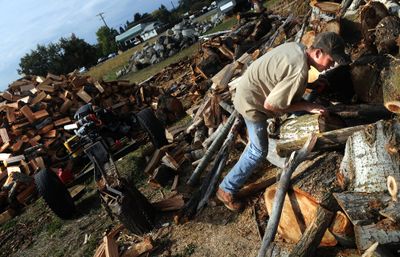Buying wood? Don’t get burned
Do homework to avoid getting shortchanged

Temperatures are dropping, and the scent of wood smoke lingers in the air. As heating oil and natural gas become more expensive, thermostats are being turned down and those who have woodstoves or fireplaces are on the prowl for firewood.
Buyers often get their leads from classified ads and bulletin boards, but not everyone is getting what they pay for.
“Unfortunately there are many fly-by-nights in this industry,” said Zan Deery, communications and investigations manager at the Better Business Bureau for Eastern Washington, North Idaho and Montana. “If someone says they are going to be back with the rest of the wood next week, they can really get you in trouble.”
The most common firewood complaint the bureau sees follows this scenario: Someone orders firewood; a partial delivery is made; the consumer pays for the full load, expecting to get the rest within a week.
“They just never get the rest of the order, and when they try calling, the phone is disconnected or something,” said Deery. “Verbal promises are a bad idea. If you can’t avoid a deal like that, get it in writing.”
Search classified ads and you’ll find wood sold by the “truckload” or by “the half bed” or “pile” – none of that works.
According to the Washington State Department of Agriculture, the only legal measure for firewood is a cord. A cord is 4 feet high, 4 feet wide and 8 feet long – or 128 cubic feet.
“People get shortchanged all the time and they don’t even know it, because they don’t know how big a cord is,” said Andrew Kilpatrick, owner of AK Tree and Landscape in Spokane Valley, which also sells firewood. “When we come out you have no idea how often people say, ‘Oh gosh, we didn’t know a cord was this much wood.’ ”
Kilpatrick said consumers should check who they purchase wood from.
“The best way to get firewood is to get it from a licensed business that’s been around,” Kilpatrick said. “Don’t buy from people on the side of the road. You don’t know where they got the wood.”
Deery agrees, adding that “you get what you pay for” definitely applies to firewood.
“You have to do your homework, especially if you are a first-time buyer,” Deery said. “Tamarack is some of the best wood, because it’s dense and it burns long and hot. Pine burns quick and easy, but it can be smoky.”
And you’ve got to know how to store it.
“It may seem obvious, but wet wood doesn’t burn well,” Deery said. “People may think there’s something wrong with the wood, when it really is the way they store it that’s wrong.”
Kilpatrick said people should buy wood in the spring, to give it time to season.
“That’s number one to me, but no one does it,” said Kilpatrick.
Also, visit a few dealers, ask your neighbors or call your county extension office to find out what the different types of wood look like.
The term “seasoned” – stored and dried properly and ready to burn – can be loosely applied.
“It’s really hard to tell if it’s dry – even for those of us who do this for a living,” said Kilpatrick. “You can’t go by weight because dense wood like tamarack is heavier than pine, even when it’s not wet.”
Kilpatrick said some shady dealers will water down the wood all summer to make it look weathered and seasoned.
“It works just like when it rains on your deck all winter, and the wood turns gray,” said Kilpatrick.
So, what is a consumer to do?
Kilpatrick said it’s best to establish a relationship with the people you buy firewood from. And don’t be afraid to ask questions.
“There are a lot of good dealers out there who deliver what you pay for,” he said.
Deery added that consumers should also check which type of wood is best in their woodstove or fireplace.
“Talk to the company that made your burn unit or ask where you bought it,” Deery said. “And compare prices just like you would with anything else.”